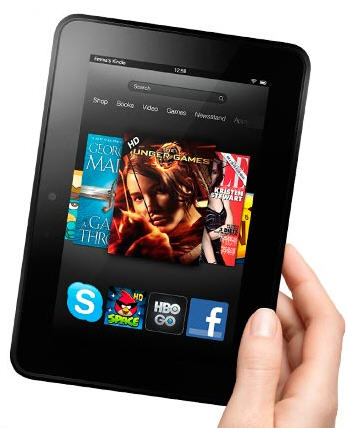
As an early user of the original Kindle Fire I was hoping for a signifcant upgrade, and Amazon didn’t disappoint. Compared to the original, the new Kindle Fire HD is slightly taller and wider and a bit thinner. Mostly it doesn’t have that boxy feel of the Amazon’s first attempt. The HD looks and feels good and — like other 7-inch tablets — it’s small enough to fit into a purse and — with a bit of pushing — I was even able to get it into my pants’ pocket, which is more that I can say for an 11-inch tablet like the current generations of iPads.
What I mostly appreciated about the new Kindle Fire HD is the enhanced screen. Its 1280 by 800 720p display is a big improvement on its predecessor. HD movies and TV shows look great and text is easy to read.
The new Kindle is also kinder to the ears. It now sports two Dolby digital speakers in the back. And unlike some tablets and laptops, the sound is loud enough to hear in almost any environment. Thankfully there is now a physical volume control on the side, making it a lot easier to adjust the volume than on the original Kindle Fire.
Virtually all tablets can run a Netflix app for streaming movies and Amazon has made its Kindle app available for other tablets as well. But if you want a tablet to screen movies from Amazon, you’ll need a Kindle Fire device. Amazon has greatly increased its library of videos that you can watch for free if you pay $79 a year for its Prime service (that also comes with free two-day shipping) and, if you purchase a video (as opposed to rent) you can download it to a Kindle Fire which enables you to watch if it you’re offline.
As with the previous Kindle Fire, the HD is all about consumption of media that you get from Amazon. While it’s operating system is based on Google’s Android, it’s been customized by Amazon not only with a different user interface but to run specially adapted Kinde Fire apps. You can’t access the Google Play app store on Amazon devices but must download (whether for free or paid) apps from Amazon’s own store. Developers have to create a special version of their apps for Kindle which — I’m told –is pretty easy to do, but there aren’t nearly as many Kindle apps as there are for Android.
Kindle Fire HD vs. Nexus 7
The Kindle Fire HD competes head on with the Google Nexus 7 and there are pros and cons for each side. The Kindle Fire HD is slightly thinner (hardly noticeable) but it’s considerably wider when held in portrait mode at 4.4 inches compared to 4.7. The HD is also a little heavier at .86 pounds vs. .74 pounds. The Nexus 7’s smaller size is an adantage, especially if you want to put it in a pocket. It’s still a tight fit, but a lot easier to slip into my jeans pocket than a Kindle Fire HD.
In terms of storage, the Kindle Fire HD is a much better deal. For $199 you get 16 gigabytes of storage compared to 8 GB for the Nexus 7. A 16 GB Nexus 7 costs $249.
The biggest advantage to the Nexus 7 is that it runs all of the Android apps but, for many uses, that won’t matter because there are plenty of great apps for Kindle Fire devices. Kindle Fire’s advantage is that it’s a simpler interface, making it easy to master, especially for the non-techie. And, if you want to get your content from Amazon, it’s clearly a great choice.
After a few days with the Kindle Fire, I came away impressed. It’s a good choice, especially for non-techie users looking for an easy to use tablet that’s great for consuming content.
Be the first to comment